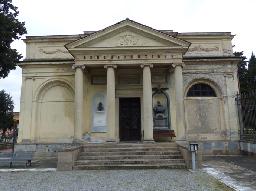Nieuwerkerke, Alfred-Émilien, comte de |
| SCULPTOR, STATESMAN (FRANCE) |
|
BORN 16 Apr 1811, Paris - DIED 16 Jan 1892, Gattaiola, Toscana (near Lucca) GRAVE LOCATION Lucca, Toscana: Cimitero, Via Tagliate di Sant'Anna (Famedio) |
|
Alfred-Émilien de Nieuwerkerke was the son of the Dutch officer Charles de Nieuwerkerke (1785-1864), who came to Paris with Louis XVIII after the 100 days. His mother was Louise-Albertine de Vassan (d.1854). In 1825 he became a page of king Charles X and in 1829 he entered the école royale de cavalerie at Saumur. He was a legitimist and he aborted his military career after the fall of Charles X in 1830. On 30 June 1832 he married Thécla (1810-1884), the daughter of count Auguste de Monttessuy. Their only child died young and they separated quickly. Before his 25th birthday he had started collecting historical weapons and soon his collection included paintings, sculptures and glass objects as well. During a stay in Italy he became devoted to ancient sculptures. After meeting Félicie de Chauveau in Florence he decided to become a sculptor himself. He took lessons with Pradier and Marochetti and exhibited at the Salon in Paris from 1842 onwards. In 1843 he presented his statue of William of Orange and it was placed at the Noordeinde in The Hague in 1845. His "Equestrian statue of Napoleon I" was unveiled in 1852 in Lyon in the presence of Prince-President Louis Napoleon Bonaparte (it was destroyed in November 1870 after the fall of the Second Empire). In 1845 he visited the collection of Anatole Demidov in Italy and Demidov's wife Mathilde Bonaparte became his lover. She left Demidov and they started living together in Paris. Their relationship lasted until 1869. In 1849 he was appointed director-general of museum, holding office at the Louvre. He supported the the coup d'état of 2 December 1851. During the Second Empire he was kind of a minister of cultural affairs. After Napoleon III's abdication he fled to England. He fell ill during his trip and received help from his friends Princess Marie Cantacuzène (1821-1891) and her daughter Olga (1843-1929). In 1871 he sold his hôtel in Paris to the collector William Henry Riggs and he sold his art collection to Richard Wallace, a friend of Napoleon III. He move to Italy to live in exile and in 1872 he bought the villa Burlamacchi at Gattaiola near Lucca. In 1873 he travelled to England to attend the funeral of Napoleon III. In 1879 he came to assist at the funeral of the Prince Imperial as well and he also visited Wallace that year. He lived in Gattaioa with Olga Cantacuzène, who became his sole heir after his death in 1892. Related persons • has a connection with Bastianini, Giovanni • made a sculpture of Napoleon III Bonaparte • was painted by Winterhalter, Franz Xaver |
| Images |
Sources • Claude Augé (ed.), Larousse Universel en 2 volumes, Librarie Larousse, 1922 • Comte de Nieuwerkerke, collector: papers - Archives Hub • Émilien de Nieuwerkerke - Wikipedia |




